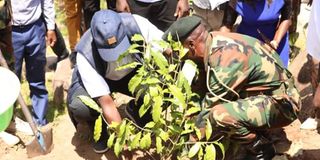Locals to get clean energy jikos to save Maragoli forest

Energy Principal Secretary Gordon Kihalangwa (left) planting a tree at Maragoli hills forest on Tuesday.
The Ministry of Energy has announced plans to donate up to 300 clean energy cooking jikos to families living near the degraded Maragoli Hills forest in Vihiga County as part of reclaiming it amid growing resistance from locals.
During a tour of the forest yesterday, Energy Principal Secretary Gordon Kihalangwa said the ministry is targeting at least 100 families in the seven villages of Muguga, Idabwongo, Buhane, Inavi, Lodonyi, Liavora and Kisingilo.
Residents have been accused of standing in the way of restoration efforts by cutting down trees and uprooting planted seedlings. Locals claim they were not involved in the conservation efforts.
The villages cover at least 40 acres said to be part of the forest.
Mr Kihalangwa, who led a drive to plant 100,000 seedlings in the 1,200-acre forest, said the jiko plan is intended to reduce overdependence on firewood.
The ministry says tree harvesting for firewood was the main promoter of deforestation.
Efforts to breathe life back into the forest have largely failed due to lack of goodwill from residents.
The jikos, Mr Kihalangwa said, would serve as a clean energy provider that will see less wood used as charcoal.
The 100,000 tree seedlings will be planted to reclaim at least 150 hectares of the forest land, with Mr Kihalangwa saying gabions will be constructed to stop soil erosion on the bare hills.
Speaking after the planting drive, he urged residents to protect the water tower.
“The Ministry of Energy has done this work in Londiani, Mau, Narok, Meru, among other areas, as we target to protect and have sufficient water. As we do this, we are also protecting life, for we all know water is life,” Mr Kihalangwa said.
Calls for demarcation
The jiko plan comes as locals want the Vihiga government to spearhead proper demarcation of the forest so as to show areas that are under residential homes and those under the forest.
The Maragoli Hills forest has suffered years of massive destruction that has left it a pale shadow of its former self.
The damage to the all-important water tower in the Western region started in the early 1990s, with locals pointing an accusing finger at the then provincial administration for perpetrating environmental crimes.
Today, only shrubs, scattered trees, nurseries, planted seedlings and rocky hills are the key features that welcome a visitor to the forest.
About 20 streams that originated from the foot of the forest have dried up.
But residents are divided on the type of seedlings to be planted, with those who have homes outside the hills preferring only fruit trees.
On the other hand, residents with homes in the forest are cautious about the types of trees to be planted but say they should not be indigenous species.
But the government and other partners are keen to reclaim the water tower by planting indigenous trees.
In a past interview, Mr James Babira, a representative of the residents, said locals were not against the conservation efforts but were raising “pertinent issues”, including the issuing of title deeds and compensation.
He said these must be addressed if the government wants to achieve the desired results.
Most of the 100 families fear they could be evicted and want to be given title deeds in addition to getting involved in reviving the forest.
Governor Wilber Ottichilo, who was with Mr Kihalangwa, said his administration wants to have non-water-friendly trees replaced with water-friendly ones in catchment and riparian lands.
“We will engage our people through public participation and agree on how we will get rid of these trees that will leave our water catchment areas dry,” Dr Ottichilo said.
“We will replace them with water-friendly trees. I am setting a policy that will control sand harvesting so that our lands are not eroded.”





